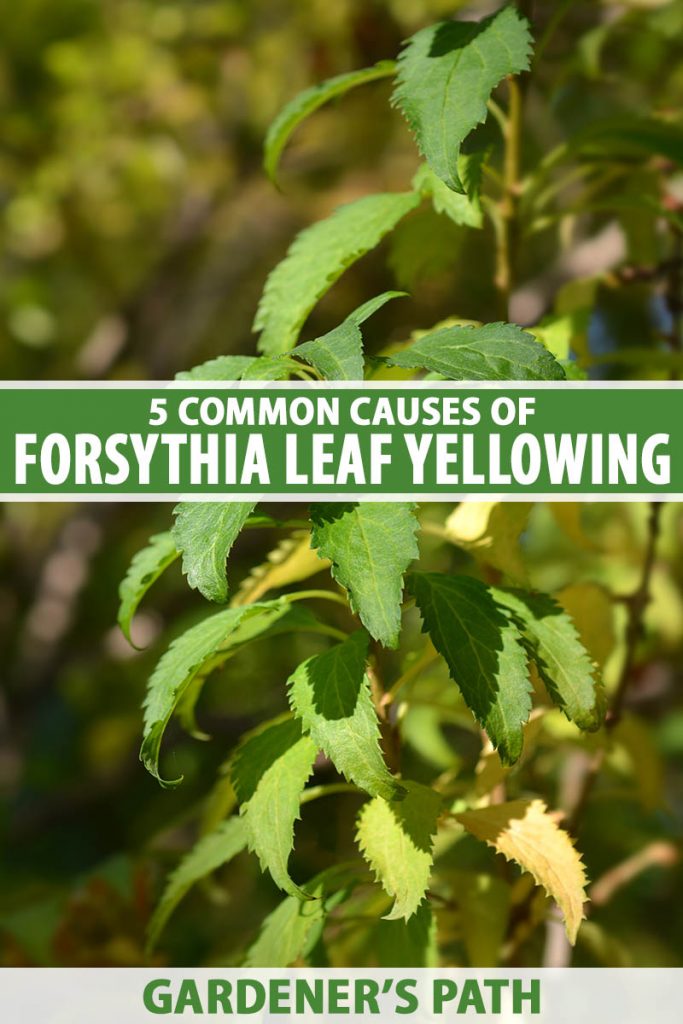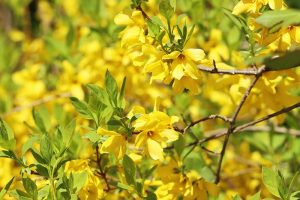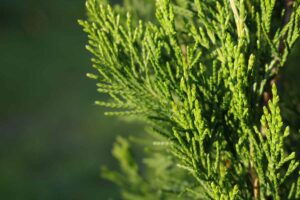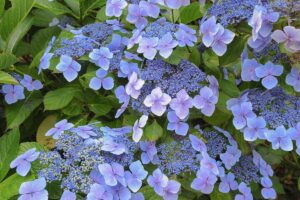Forsythia (Forsythia spp.) is a deciduous woody shrub suited to USDA Hardiness Zones 5 to 8 that is covered in bright yellow flowers in late winter to early spring.
There are many cultivated varieties. Some have variegated leaves of green and yellow.
Others shade from green to yellow, bronze, red, or purple as the weather cools down in autumn.
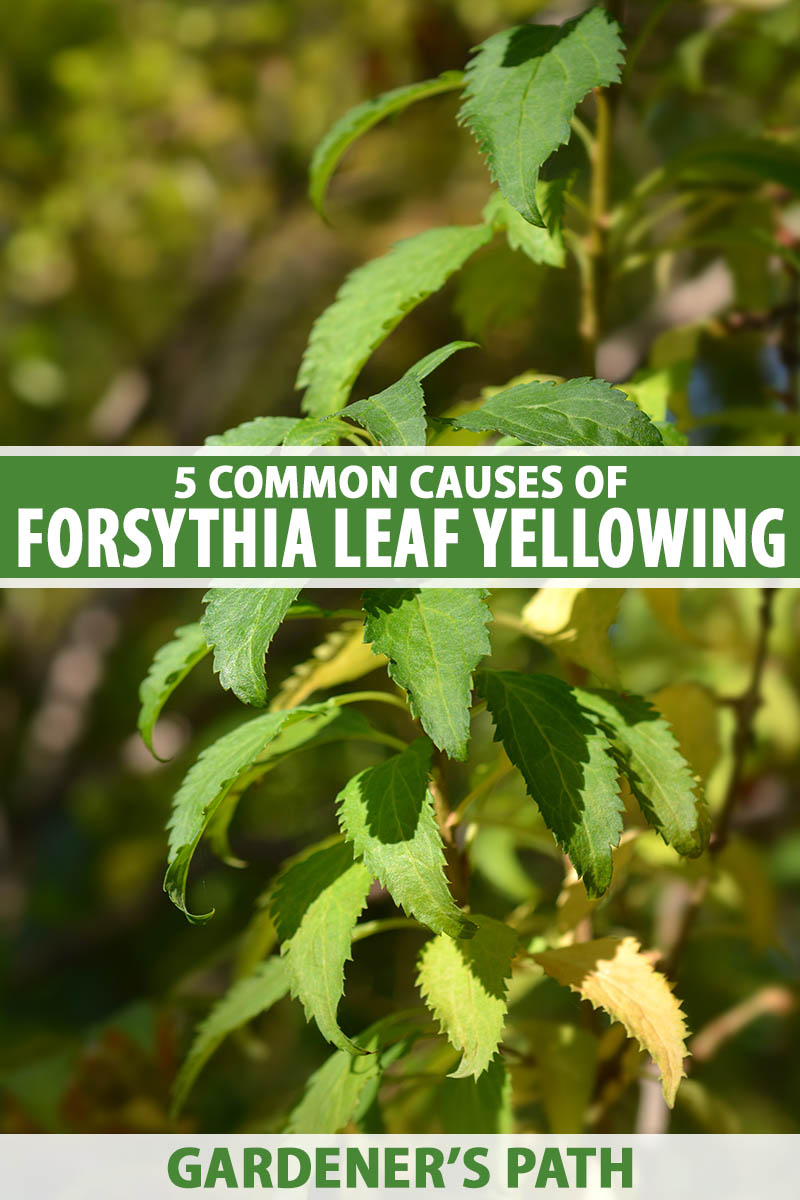
We link to vendors to help you find relevant products. If you buy from one of our links, we may earn a commission.
However, when a normally green shrub’s leaves fade to yellow during the growing season, something is amiss in the garden. This yellowing phenomenon is called “chlorosis.”
In our guide to growing forsythia, we discuss everything you need to know to cultivate and care for forsythia in your landscape.
This article focuses on five common causes of forsythia leaf yellowing and how to address them.
What You’ll Learn
Let’s start with some botany.
What Is Chlorosis?
Chlorosis, or leaf yellowing, is the result of a lack of chlorophyll, the green pigment in plants that absorbs energy from sunlight to contribute to food production, or photosynthesis.

Affected foliage may appear to be a lighter shade of green, before turning yellow. The leaf veins may stand out like green accents at first, before lightening as well.
If conditions don’t improve, the leaves may turn brown and drop.
In time, the malnourished plant is likely to die as well.
As serious as it sounds, chlorosis can be prevented with proper care.
Growing Forsythia
There are numerous reasons why foliage may turn yellow, and one or more may be attributed to a given episode.
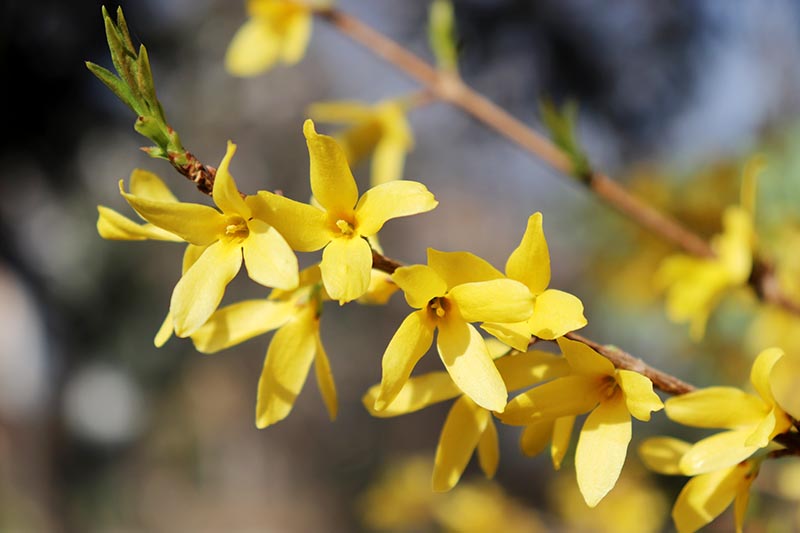
For forsythia to perform well in the landscape, we must meet its needs by providing the following:
- Cultivation in an appropriate growing zone
- Full sun
- Average to organically-rich soil
- Soil pH of 6.5-7.5
- Weekly watering, about one inch
- Pruning to keep plants vigorous and promote air circulation
- Weeding to inhibit pests and contribute to good air circulation
- Treatment of pests and diseases as needed
When these conditions are not met, shrubs become stressed in ways that can cause yellowing.
5 Common Causes of Chlorosis
Chlorotic leaves are a plant’s way of expressing stress. It’s our job as gardeners to figure out what’s going on.
Here are five likely causes of foliar yellowing during the growing season, and ways to address them:
1. Moisture Stress
Ironically, both insufficient and excessive amounts of water can cause leaves to become discolored. Let’s talk about each.
Too Little Water
Even a drought-tolerant plant can only take so much.
A prolonged lack of water due to little rain and insufficient supplemental water can cause leaves to turn yellow. Without moisture, plants stop growing, and the leaves may wilt, become discolored, dry up, and drop.
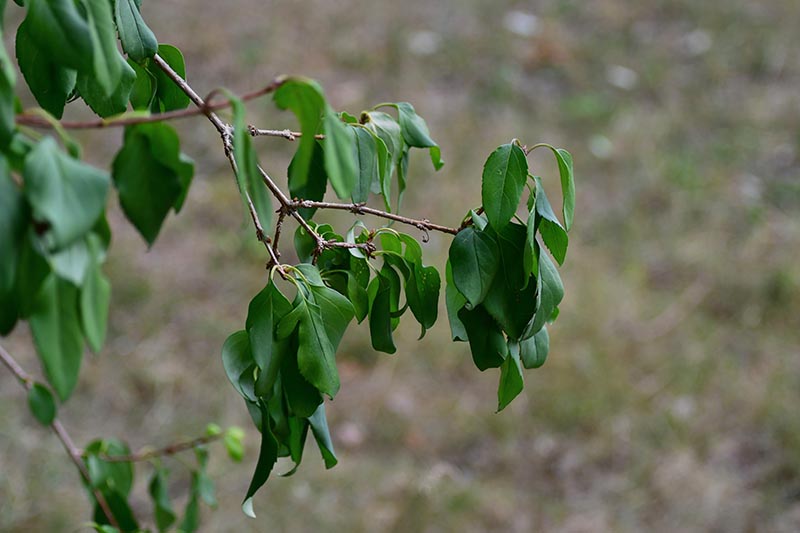
A shrub without water is one that can’t feed itself. To restore it, you need to give it a deep watering, and then one inch of water per week in the absence of rain.
Stimulate new growth by using clean pruners to remove up to one-third of the stems at their points of origin.
In cases of severe dehydration, prune all stems at their lowest points to try to revive the shrub.
Too Much Water
An overabundance of rain, or being too generous with the hose, can result in soggy soil, especially when drainage is inadequate.
And repeated or prolonged oversaturation can cause roots to become waterlogged, impairing respiration and nutrient uptake.
Affected foliage wilts, yellows, and drops, as the roots become vulnerable to fungal disease and rotting.
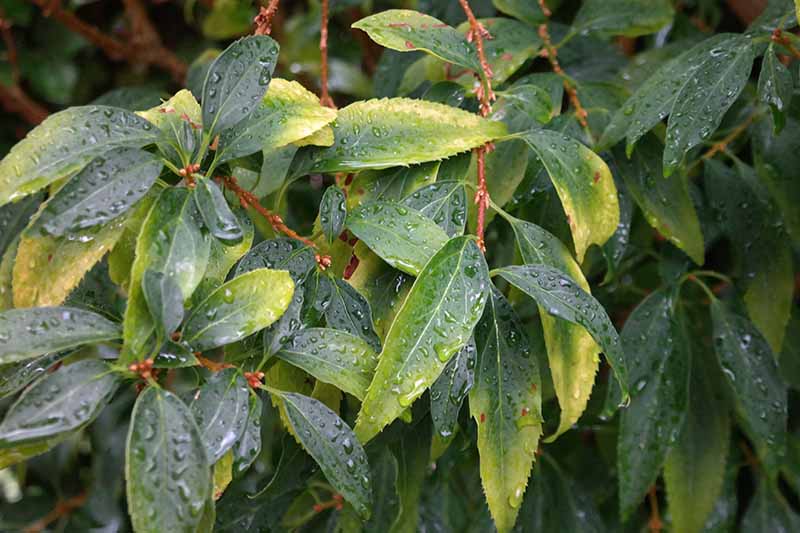
For compacted soil, loosen the earth around the bush and mix in equal parts of sand and compost to promote better drainage.
If a shrub sits in a depression, below the ground around it, you can dig it out, mound up well-draining soil, and replant it a few inches higher than the surrounding terrain.
2. Pests and Disease
When plants are not in optimal condition, they are more likely to suffer from pest damage and disease, both of which can also cause yellowing.
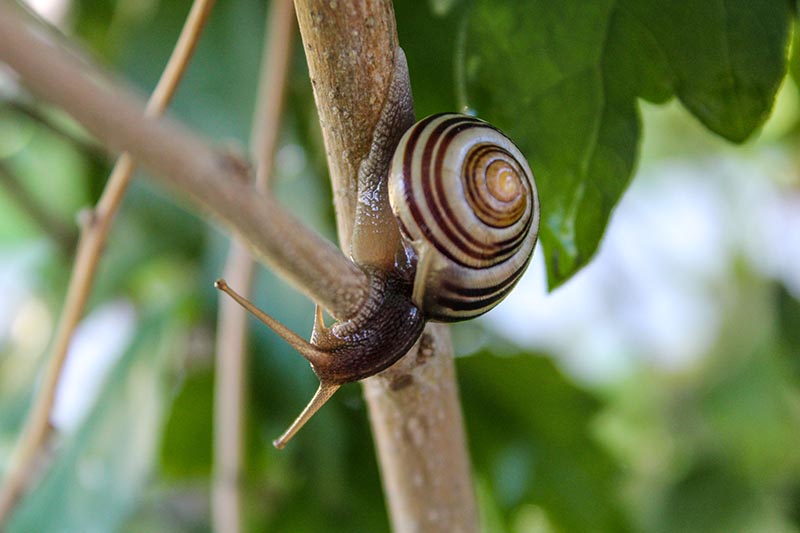
Discoloration may occur in the form of yellow patches, followed by browning and foliar tissue death.
Shrubs that suffer from a lack of water are vulnerable to insects like aphids, mites, and scale, as well as diseases they carry, such as leaf spot and mosaic virus.
Sap-sucking bugs can often be rinsed away with a spray from the garden hose. For persistent pests, apply organic neem oil as needed.
Plants that are waterlogged may become a breeding ground for soilborne root-knot nematodes and an attraction to slugs and snails.
They may also fall victim to diseases that are fungal in nature, such as powdery mildew and white mold.
There are pesticides for nematodes, and fungicides to destroy mold spores.
3. Nutritional Deficiency
When roots can’t take up water and food because they are over- or undersaturated, nutritional deficiencies may occur that can cause foliar discoloration.
A lack of iron, for example, is a nutrient deficiency that is often responsible for chlorotic foliage. Although the soil may contain this essential mineral, the roots can’t absorb it if it’s too wet, resulting in poor chlorophyll production and yellowing.
The bioavailability of iron is also poor in compact soil and earth in which the alkalinity is too high.
The ideal soil pH for forsythia is 6.5 to 7.5.
To determine your soil’s pH, conduct a soil test. Alkaline soil can be sweetened with the addition of organically-rich aged compost.
Avoid using foliar iron sprays to treat this problem, as they don’t address issues at the soil level. Addressing watering and drainage is a better approach to making iron readily available.
4. Mechanical Damage
Sometimes a shrub is damaged by lawn cutting equipment and we don’t realize a string trimmer or mower blade has slit a branch, until the foliage withers and yellows.
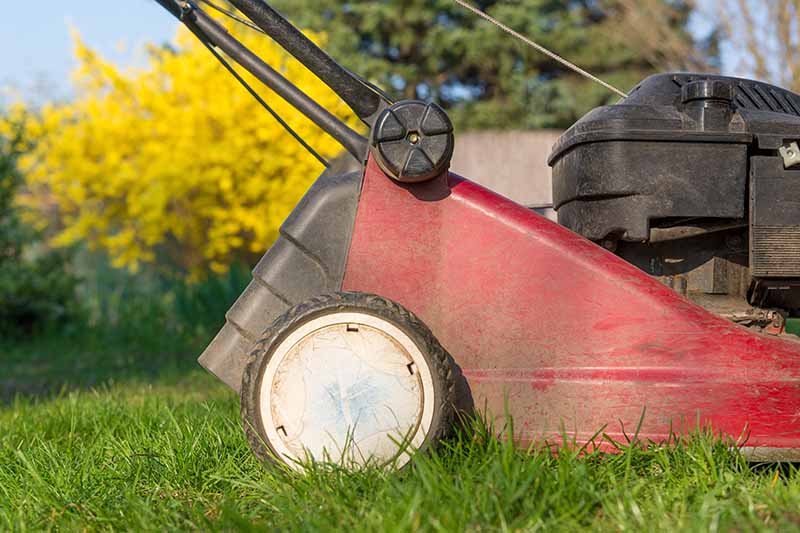
Such injury is an isolated incident that does not affect the shrub’s overall health. Prune the damaged stem off at its point of origin.
5. Toxic Exposure
Finally, it’s possible that a bush is showing the ill effects of having been inadvertently sprayed with an herbicide meant for weeds.
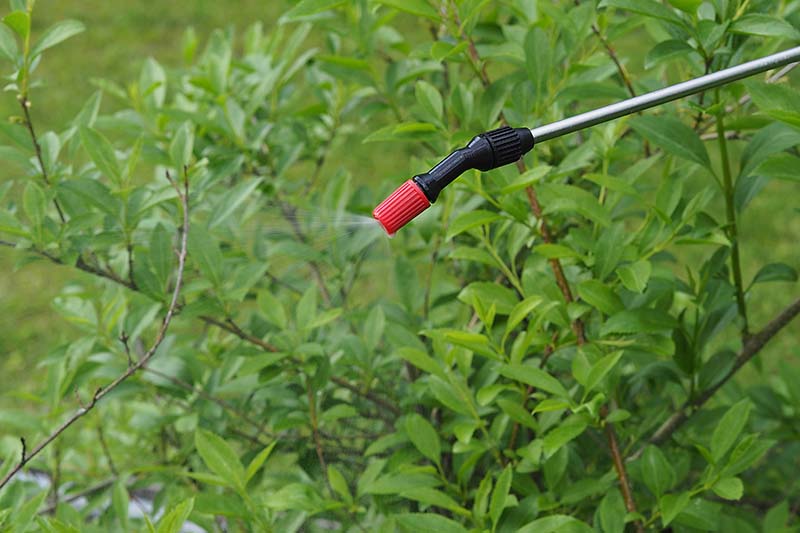
If you suspect this is the case, spray the plant down with the hose, and prune up to one-third of the stems off at their points of origin to stimulate fresh, healthy growth.
Living the Green Life
Forsythia is generally a healthy shrub that’s not fussy about soil, tolerates drought, and grows like a weed.

But when moisture stress, pests and disease, nutritional deficiency, mechanical damage, and toxic exposure start a downward spiral, we need to act quickly to restore the growing environment, and ensure armloads of beautiful spring blooms followed by lush greenery all season long.
Do you grow forsythia? Have the leaves turned yellow? Share your experience with us in the comments section below.
If you found this article informative and want to learn more about forsythia care, we recommend these guides for further reading:
